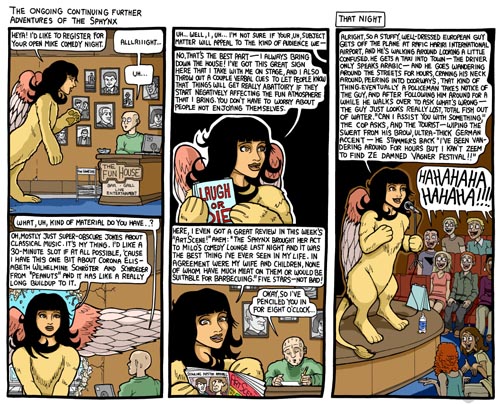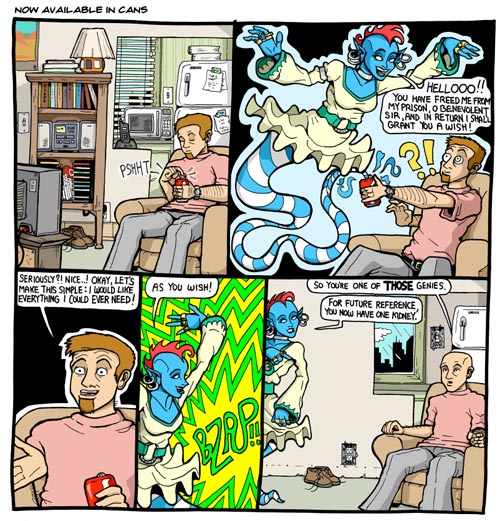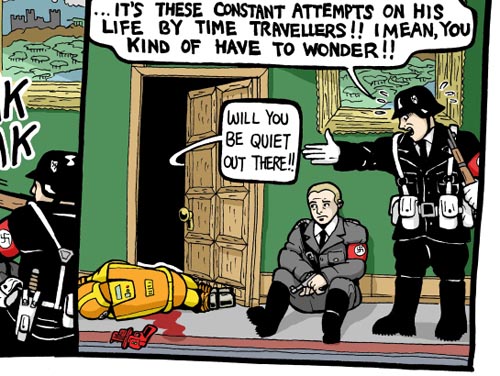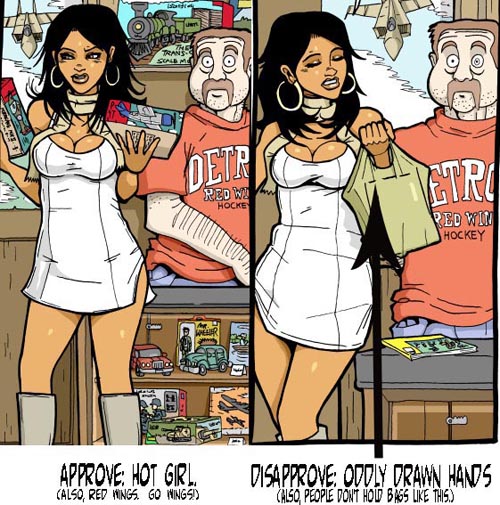
BAD REVIEWS
Review: "Untitled"
”...Many of the other stories lack...depth or awareness of consequences. These stories tend to be written by Americans about the war in Iraq. And you know it’s not an “artistic statement” about the war until the arrival of the Hitler reference. “Untitled” by Winston Rowntree begins with two teenagers, late for some unspecified event, talking down a country road. The conversation quickly turns to politics. “Can I assume you’re referring to old you-know-who, the leader of a certain country which shall remain nameless?” the boy asks. The girl responds, “One look at that beady-eyed monster and it’s hard not to just give up on life.” It becomes obvious they’re talking about the Bush administration, with the references to a stolen election and a non-responsive left wing. But no! It’s not Bush, but Hitler! These are two Jewish youths late for their meeting… with DEATH! Nazi soldiers strip the girl and kill them both and the inevitable comparison to Hitler has been made. It’s a lazy, boring political statement, and unfortunately, Rowntree is not the only writer to use it.”
--Jessa Crispin, bookslut.com
Review: "Untitled"
”The only serious competition [for the worst story in the anthology] is Winston Rowntree’s awkward ‘shock’ story that evokes a 1941 massacre of Jews in the Ukraine to make a well-worn Bush = Fascist comparison. I’m sure the intent was to extract disturbing power from the dissonance between the cutesy-pie opening and the abrupt brutality of the ending, but it struck me as an overwhelmingly heavy-handed means of highlighting an already stale talking-point.”
--joglikescomics.blogspot.com
Review: "Subnormality"
In an earlier post, I remarked that webcomics were the new independent comic book scene. I can’t take credit for that analogy; I remember reading it somewhere online, but for the life of me I can’t remember who said it. There’s a huge difference though, between “independent” and “indie.” In fact, the “indie” term can no longer be considered a shorthand of “independent,” since the term has taken a life of its own and now alludes to an attitude rather than a business model.
For example, what’s your favorite indie comic book? A few of you probably said Peter Bagge’s Hate! A few others might mention David Sim’s Cerebus. Some old timers might profess their love for Love & Rockets. And I’m sure some of you had Neil Gaiman’s Sandman on the tip of your tongue, but weren’t sure if something under a DC imprint totally qualified as indie or not.
What you probably didn’t say was Jeff Smith’s Bone, which is beloved by all. According to Wikipedia, Bone is “one of the longest-running self-published comic book series by a single writer/artist.” It’s just too polished and too kid friendly! It’s not at all something that someone with jet black hair, too much mascara, and a love of punk music would ever consider “indie”! (I have seen some of Mr. Smith’s earlier, pre-comic book Bone strips, which I assume he created in his college years. Ironically, they would have easily been regarded as “indie.”)
While I said that I have been covering the “indie” comics of the independent comic genre, that’s not totally true. None of the comics I’ve reviewed really exemplify the type of comic enjoyed by disaffected liberal arts college students. The type of comic that strives to be more than simply entertainment and tries to make a the world a better place. Something that echoes the anxieties and black humor of young adults.
That changes today. Generation X may have come and gone, but its spirit — or at least its aesthetic — lives on in the subject of today’s Webcomic Overlook: Winston Rowntree’s indie-flavored webcomic, Subnormality.

Full disclosure, by the way: Mssr. Rowntree sent me an e-mail asking if I wouldn’t mind reviewing his webcomic. He only requested one thing: to provide an honest analysis, even if I savage the hell out of it. (I took a glance at Winston’s review section, and he proudly displays both positive and negative reviews. An encouraging sign.) El Santo smiles on that sort of moxie. I always dish out my honest opinion anyway, but it’s refreshing when the author very authoritatively assures you that he’s on the same page.
Also, the man knows how to dress impeccably.
Subnormality is a collection of gag strips with various themes near and dear to hearts of today’s young, North American adults. Although Rowntree covers a wide assortment of subjects and themes, he sticks closely to politics, sociology, and alternative music (especially if it means slamming Nickelback). Or, to put it succinctly and rather rudely, anything that pisses Rowntree off. (To give Winston some credit, though, he does it with heaping doses of absurdity and self-deprecation.)
There are only a few recurring characters. The most visual striking is The Sphinx, an ultra-feminist, perpetually irate creature who is blessed with both a pretty, Egyptian face a fearsome leonine body that pretty much assures that she’ll always get her way. Another is a pink-haired consumer who is a hapless victim to the annoying shortfalls of customer service.
At some point in his life, Mssr. Rowntree must’ve developed a vile hatred of Shakespeare, or Hamlet’s Lord Polonius at least, because Subnormality frequently seems to be at war with the phrase, “Brevity is the soul of wit.” (And yes, I’m aware that’s a pretty ironic statement coming from someone who regularly types out 2,000+ word webcomic reviews.) In Subnormality, Rowntree fills entire panels with gibberish for no other reason than to hammer home the point that, “Boy, people sure are chatty, aren’t they?”
To drive the point home, here is the complete dialogue in panel two of strip #417:
Basically, I’ve posed the question: is it enough to merely decide to build a time machine to set in motion a series of events that will result in instantaneus and drastic changes across the time continuum — the changes becoming visible, in fact, at the very moment the decision is made — or do you instead have to complete a finished time machine before such changes occur? The changes, of course, resulting from the inevitable misuse of the time machine by those whou would out of curiousiity or malice travel back in time and deliberately or inadvertently cause significant deviations in the course of history. I’ve argued that it’s impossible — that you would actually have to build the thing before anything would happen, amd moreover, that nothing would happen anyway becuase consequent to its construction the technology would be considered so dangers as to be prohibited in use — much like nuclear weapons, human cloning, and so on. No one would have the chance to misuse it, and so the point is moot.
Whew! And that’s not counting the equally long rebuttal in panel three. So after all this talk and a dig at professor types reducing everything to a stupid wager, the punchline is … meddling with time becomes Nazi Germany?
What?

At the risk of sounding like an internet meme, I see what Rowntree did there. We’re supposed to laugh because the two eggheads argue over a crucial issue and come at an impasse, only to throw it all away over a stupid bet. However, does all the text make the strip any funnier? If you gloss over the text like it were some sort of alpha-numeric based wallpaper, then the punchline feels trite. If you actually stop to read the text, then the punchline feels disappointing. It doesn’t matter if dialogue is placed in the mouths of pushy salespersons or waitresses: long, pointless dialog is just not funny.
It would be easy for me to say that Rowntree just doesn’t know how to tell a joke. Untrue. Among my favorites are an artistically minimalist strip on an irony detector and a Christmas strip about a suave Santa. Plus, you just can’t go wrong with a strip about Hitler getting attacked by time travelers. But do you know what’s the common denominator with all these strips? None of them are pointlessly wordy! Plus, they have decent punchlines, and I’m all over that crazy non-sequitur action.
Besides, Rowntree has demonstrated success with “conventional” humor before. Over time, Virus Comix — the parent title — changes and evolves, much like a bacteria … and not like a virus, which spreads but remains pretty much the same hexagonal form, if I remember my high school AP Biology correctly. (You folks with medical degrees can chime in whenever you want.) Subnormality (which mysteriously starts at page 324) is perhaps only the most recent of a long string of experiments. If you dig back far enough, you come across several past projects with more conventional forms of humor: a series of comedic public service announcements starring the ultra-violent Jumbo Ranger, and a parody of children’s books called Things They Don’t Tell You. I found all of these past efforts to be genuinely humorous. (And by the way, what kind of world do we live in where a trigger-happy armored law enforcer can be considered too mainstream?)
One of his earliest works though, is Gee, Marie, a fairly tame strip that was meant to be printed in newspapers. Rowntree gamely prints a couple of rejection strips he received from the syndicates, including one that advises “try to use less dialog.“
Hum.

Perhaps the long strings of dialog is an experiment of some sort? Perhaps Rowntree is an Andy Kaufman of webcomics: deliberately making the reader uncomfortable through protracted spells of awkwardness, and then turning the tables when the reader laughs at the absurdity of the situation. Or maybe this can be directly tied to content of that rejection letter? Since simpler dialog is easily the lowest common denominator for the unwashed masses, can longer dialog cater to a more sophisticated crowd?
If Subnormality is any sort of indicator, the answer is: not always. The Perry Bible Fellowship is one of the most sophisticated comics around, yet is one of the world’s best examples of the brevity/wit theory.
I found that the wordiest strips failed for the most part in medium where communication is more than 50% visual. That’s not to say that it doesn’t work from time to time. “The Future” features a dialog-rich argument between a couple debating over the semantics of past, present, and future. And, I have to say, the punchline is rather creative. What makes this work? The logorrheic discussion actually means something.
I also have some issues with the childishness of the political strip, which more or less boil down to “Dubya sucks and looks like a dog/rat/snake/weevil.” That is some seriously lazy political commentary. But, you know, I won’t harp on it too much. I pretty much spent all my mental energy trying to deconstruct the long-windedness of the Subnormality strips. Besides, I don’t want to give the impression that Rowntree is on a political crusade. They’re rather rare, actually. I suppose I should cut foreign cartoonists (and yeah, Canada is foreign) slack over simplistic editorials. We Americans aren’t really above the lazy stereotyping of foreign world leaders ourselves. I mean, I thought Kim Jong Il was hilarious in Team America: World Police.
The art is quite nice, by the way. I ran into a highly rated panel of Subnormality on reddit before I sat down to do a formal review, and I have to say that the illustrations — and the colors, particularly — were very eye-catching. Rowntree illustrates with traditional pen-and-ink. As a result, Subnormality feels more organic and personal than the soulless Flash-based comics that dominate the web these days.
And I’ve got to had it to him, despite his gripe on how women are portrayed as unattainable Barbie dolls in comic books, Rowntree knows how to draw aestheically pleasing hotties. He runs into a couple of problems with poses. Sometimes his characters stand in positions that look too stiff or too unnatural (see below). Those are minor quibbles, though. What matters is that the illustrations manage to retain an appearance that looks right at home in an alternative weekly.

Subnormality is very experimental, yet it’s not altogether successful. It’s not Rowntree’s best project on the Virus Comix site, though it is the prettiest. If I had to recommend one project on Virus Comix that would be worth your while, it would be Captain Estar Goes to Heaven, a fairly moody, well paced thriller about a bounty hunter and the ultimate prize.
For a humor strip, Subnormality is rarely laugh-out-loud funny. It is, however, frequently clever. It’s too cultured to stoop to gross-out jokes, yet isn’t too stuffy to show Keanu Reeves in a blender. If you plan on reading this, take it one strip at a time. The dialogue can be hellishly fatiguing.
--Larry “El Santo” Cruz, The Webcomics Overlook